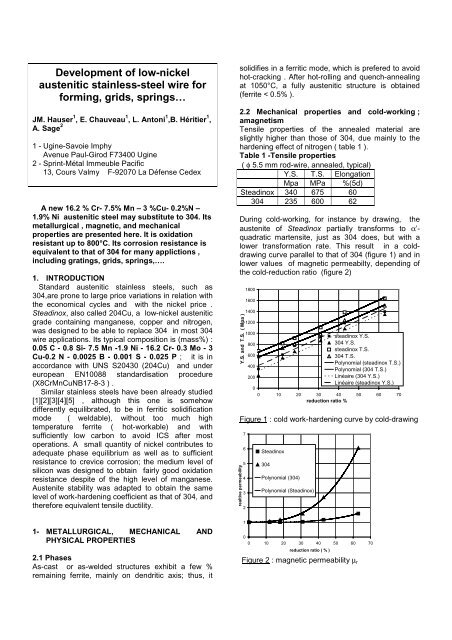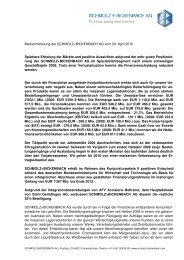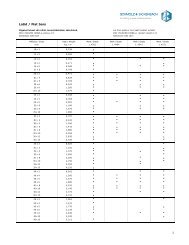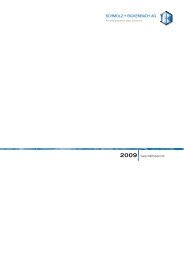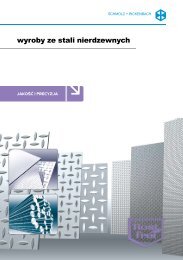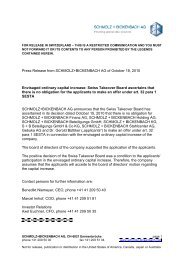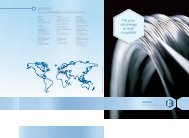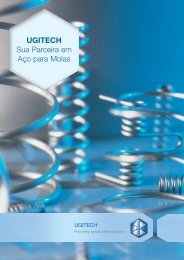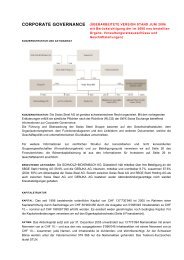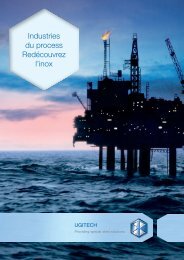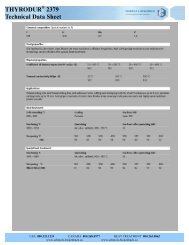Development of low-nickel austenitic stainless-steel wire for forming ...
Development of low-nickel austenitic stainless-steel wire for forming ...
Development of low-nickel austenitic stainless-steel wire for forming ...
Create successful ePaper yourself
Turn your PDF publications into a flip-book with our unique Google optimized e-Paper software.
<strong>Development</strong> <strong>of</strong> <strong>low</strong>-<strong>nickel</strong><br />
<strong>austenitic</strong> <strong>stainless</strong>-<strong>steel</strong> <strong>wire</strong> <strong>for</strong><br />
<strong>for</strong>ming, grids, springs…<br />
JM. Hauser 1 , E. Chauveau 1 , L. Antoni 1 ,B. Héritier 1 ,<br />
A. Sage 2<br />
1 - Ugine-Savoie Imphy<br />
Avenue Paul-Girod F73400 Ugine<br />
2 - Sprint-Métal Immeuble Pacific<br />
13, Cours Valmy F-92070 La Défense Cedex<br />
A new 16.2 % Cr- 7.5% Mn – 3 %Cu- 0.2%N –<br />
1.9% Ni <strong>austenitic</strong> <strong>steel</strong> may substitute to 304. Its<br />
metallurgical , magnetic, and mechanical<br />
properties are presented here. It is oxidation<br />
resistant up to 800°C. Its corrosion resistance is<br />
equivalent to that <strong>of</strong> 304 <strong>for</strong> many applictions ,<br />
including gratings, grids, springs,….<br />
1. INTRODUCTION<br />
Standard <strong>austenitic</strong> <strong>stainless</strong> <strong>steel</strong>s, such as<br />
304,are prone to large price variations in relation with<br />
the economical cycles and with the <strong>nickel</strong> price .<br />
Steadinox, also called 204Cu, a <strong>low</strong>-<strong>nickel</strong> <strong>austenitic</strong><br />
grade containing manganese, copper and nitrogen,<br />
was designed to be able to replace 304 in most 304<br />
<strong>wire</strong> applications. Its typical composition is (mass%) :<br />
0.05 C - 0.8 Si- 7.5 Mn -1.9 Ni - 16.2 Cr- 0.3 Mo - 3<br />
Cu-0.2 N - 0.0025 B - 0.001 S - 0.025 P ; it is in<br />
accordance with UNS S20430 (204Cu) and under<br />
european EN10088 standardisation procedure<br />
(X8CrMnCuNB17-8-3 ) .<br />
Similar <strong>stainless</strong> <strong>steel</strong>s have been already studied<br />
[1][2][3][4][5] , although this one is somehow<br />
differently equilibrated, to be in ferritic solidification<br />
mode ( weldable), without too much high<br />
temperature ferrite ( hot-workable) and with<br />
sufficiently <strong>low</strong> carbon to avoid ICS after most<br />
operations. A small quantity <strong>of</strong> <strong>nickel</strong> contributes to<br />
adequate phase equilibrium as well as to sufficient<br />
resistance to crevice corrosion; the medium level <strong>of</strong><br />
silicon was designed to obtain fairly good oxidation<br />
resistance despite <strong>of</strong> the high level <strong>of</strong> manganese.<br />
Austenite stability was adapted to obtain the same<br />
level <strong>of</strong> work-hardening coefficient as that <strong>of</strong> 304, and<br />
there<strong>for</strong>e equivalent tensile ductility.<br />
1- METALLURGICAL, MECHANICAL AND<br />
PHYSICAL PROPERTIES<br />
2.1 Phases<br />
As-cast or as-welded structures exhibit a few %<br />
remaining ferrite, mainly on dendritic axis; thus, it<br />
solidifies in a ferritic mode, which is prefered to avoid<br />
hot-cracking . After hot-rolling and quench-annealing<br />
at 1050°C, a fully <strong>austenitic</strong> structure is obtained<br />
(ferrite < 0.5% ).<br />
2.2 Mechanical properties and cold-working ;<br />
amagnetism<br />
Tensile properties <strong>of</strong> the annealed material are<br />
slightly higher than those <strong>of</strong> 304, due mainly to the<br />
hardening effect <strong>of</strong> nitrogen ( table 1 ).<br />
Table 1 -Tensile properties<br />
( φ 5.5 mm rod-<strong>wire</strong>, annealed, typical)<br />
Y.S. T.S. Elongation<br />
Mpa MPa %(5d)<br />
Steadinox 340 675 60<br />
304 235 600 62<br />
During cold-working, <strong>for</strong> instance by drawing, the<br />
austenite <strong>of</strong> Steadinox partially trans<strong>for</strong>ms to α’quadratic<br />
martensite, just as 304 does, but with a<br />
<strong>low</strong>er trans<strong>for</strong>mation rate. This result in a colddrawing<br />
curve parallel to that <strong>of</strong> 304 (figure 1) and in<br />
<strong>low</strong>er values <strong>of</strong> magnetic permeabilty, depending <strong>of</strong><br />
the cold-reduction ratio (figure 2)<br />
Y.S. and T.S. ( Mpa )<br />
realtive permeability<br />
1800<br />
1600<br />
1400<br />
1200<br />
1000<br />
800<br />
600<br />
400<br />
200<br />
0<br />
0 10 20 30 40 50 60 70<br />
reduction ratio %<br />
Figure 1 : cold work-hardening curve by cold-drawing<br />
7<br />
6<br />
5<br />
4<br />
3<br />
2<br />
1<br />
Steadinox<br />
304<br />
Polynomial (304)<br />
Polynomial (Steadinox)<br />
Figure 2 : magnetic permeability µr<br />
steadinox Y.S.<br />
304 Y.S.<br />
steadinox T.S.<br />
304 T.S.<br />
Polynomial (steadinox T.S.)<br />
Polynomial (304 T.S.)<br />
Linéaire (304 Y.S.)<br />
Linéaire (steadinox Y.S.)<br />
0<br />
0 10 20 30 40 50 60 70<br />
reduction ratio ( % )
3. HIGH TEMPERATURE BEHAVIOUR<br />
3.1 Mechanical behaviour<br />
Annealed 204Cu <strong>wire</strong>s exhibit high tensile strength,<br />
at the same level as AISI 347 [6], up to 800°C<br />
(figures 3 ), with secondary hardening in the range<br />
500-800°C, due probably to chromium nitride<br />
precipitation ( no sigma phase was observed in that<br />
range ) .<br />
Y.S., U.T.S. ( Mpa)<br />
Y.S. ( Mpa )<br />
800<br />
700<br />
600<br />
500<br />
400<br />
300<br />
200<br />
100<br />
400<br />
300<br />
200<br />
100<br />
STEADINOX<br />
EL %<br />
U.T.S.<br />
Y.S.<br />
EL%<br />
0<br />
0<br />
0 200 400 600 800 1000<br />
Temperature °C<br />
316L<br />
steadinox<br />
347<br />
304<br />
321<br />
0<br />
0 200 400 600 800<br />
Temperature °C<br />
1000<br />
Figures 3 : high temperature tensile properties<br />
100<br />
3.2 Scaling<br />
High temperature oxidation properties <strong>of</strong> Steadinox<br />
has been compared with that <strong>of</strong> a classical AISI 304<br />
(18.0 Cr 11.1Ni 1.3 Mn 0.5 Si 0.05 C 0.04 N bal.<br />
Fe),using cylindrical samples (φ4x30 mm) from<br />
industrial <strong>wire</strong>s. Metal losses were measured after<br />
descaling the samples by a chemical procedure [7].<br />
The maximum operation temperature Tmax <strong>of</strong> these<br />
grades has been determined fol<strong>low</strong>ing the definition<br />
incorporated in the draft <strong>of</strong> EN 10295 [8], known as<br />
the 5 x 24 h test. The results are presented in figure<br />
4. It can be deduced that Tmax is almost the same<br />
<strong>for</strong> both grades and equals 870°C.<br />
90<br />
80<br />
70<br />
60<br />
50<br />
40<br />
30<br />
20<br />
10<br />
Metal Loss (g/m²/h)<br />
10<br />
9<br />
8<br />
7<br />
6<br />
5<br />
4<br />
3<br />
2<br />
1<br />
T max : Metal loss < 1 g/m²/h at T max<br />
and Metal loss < 2 g/m²/h at T max+50°C<br />
steadinox<br />
304<br />
0<br />
650 750 850<br />
Temperature (°C)<br />
950 1050<br />
Figure 4 : Metal loss vs. temperature plots <strong>for</strong><br />
the isothermal oxidation in still air <strong>of</strong> alloys<br />
Steadinox and 304 after 5 x 24 h testing time.<br />
The resistance to thermal cycling <strong>of</strong> these materials,<br />
which can strongly influence their lifetime in service<br />
conditions [9] has been characterized at 800°C up to<br />
1200 cycles (or 400 h total dwell time) using a severe<br />
thermal cycle described elsewhere [7]. Figure 5<br />
indicates that both grades behave analogously.<br />
Metal Loss (g/m²)<br />
8<br />
7<br />
6<br />
5<br />
4<br />
3<br />
2<br />
1<br />
0<br />
number <strong>of</strong> cycles<br />
0 300 600 900 1200<br />
steadinox<br />
304<br />
0 100 200 300 400<br />
Total Dwell Time (h)<br />
Figure 5 : Metal loss vs. total dwell time plots<br />
<strong>for</strong> the cyclic oxidation in still air <strong>of</strong> alloys<br />
Steadinox and 304 at 800°C (thermal cycle :<br />
20 min dwell time, 5 min air <strong>for</strong>ced cooling)
4 . CORROSION RESISTANCE : GENERAL<br />
BEHAVIOUR<br />
This part includes a comparison <strong>of</strong> Steadinox, 430<br />
(1.4016) and 304 (1.4301) <strong>for</strong> different types <strong>of</strong><br />
corrosion in several chemical solutions.<br />
4.1 CORROSION RESISTANCE IN A HIGHLY<br />
CHLORINATED MEDIUM : CREVICE CORROSION<br />
In some complicated confined areas, an acid solution<br />
may exist, by the crevice corrosion mechanism,<br />
which is studied by several electrochemical tests.<br />
Electrochemical test <strong>for</strong> crevice corrosion :<br />
measurement <strong>of</strong> depassivation pH : the <strong>low</strong>er this<br />
pHd, the higher the corrosion resistance ; pHd is<br />
evaluated using the dissolution current on a<br />
polarisation curve at different pH values (1,5 à 3) in a<br />
highly chlorinated ( 2M ) solution at 23°C : pHd is<br />
obtained at 10 µA/cm².<br />
Figure 6 shows the variation <strong>of</strong> the dissolution<br />
current at several pH values <strong>for</strong> 304 , Steadinox and<br />
430. .<br />
i critical (µA/cm²)<br />
1200<br />
1000<br />
800<br />
600<br />
400<br />
200<br />
CREVICE CORROSION TEST in NaCl 2M, 23°C<br />
430<br />
Steadinox<br />
304<br />
0<br />
1,5 1,7 1,9 2,1 2,3 2,5 2,7 2,9 3,1<br />
Figure 6 : electrochemical dissolution current<br />
Steadinox appears to be equivalent to 304 :same<br />
depassivation pH and same speed <strong>of</strong> crevice’s<br />
growth ( represented by the slope <strong>of</strong> the curve ) .<br />
4.2 STRESS CORROSION RESISTANCE<br />
Stress corrosion resistance is studied by tensile<br />
testing in a solution <strong>of</strong> MgCl2 boiling at 155°C : it is<br />
defined as the critical de<strong>for</strong>mation speed, under<br />
which the tensile strength and the rupture elongation,<br />
measured in corrosive solution, are <strong>low</strong>er than those<br />
in an inert silicon oil ( or <strong>low</strong>er than at very high<br />
speed <strong>of</strong> de<strong>for</strong>mation in corrosive solution ) .<br />
Steadinox and 304 both have a critical speed <strong>of</strong><br />
about 2.10 -3 s -1 , and are thus equivalent .<br />
pH<br />
4.3 PITTING CORROSION RESISTANCE IN A<br />
WEAKLY CHLORINATED SOLUTION<br />
4.3.1 Methods<br />
Pitting corrosion was studied <strong>for</strong> NaCl 0,02M to 2M ;<br />
pH 2 to 6,6 ; temperature 23°C to 50°C ; with or<br />
without an oxidizing agent in the solution.<br />
Using the OCP (Open Circuit Potential)<br />
electrochemical test, the potential <strong>of</strong> the sample in a<br />
corrosive solution was measured along 5 days<br />
,leading to different kinds <strong>of</strong> behaviour :<br />
*behaviour A : stable potential, no corrosion on the<br />
sample,<br />
*behaviour B : some variations <strong>of</strong> the potential; the<br />
depth and the length <strong>of</strong> the variations are small :<br />
unstable repassivating pits ; corrosion is not<br />
dangerous in these conditions ;<br />
*behaviour C : deep variations <strong>of</strong> potential (very<br />
cathodic potential’s value <strong>for</strong> example) : pits are<br />
growing ; there is pitting corrosion on the sample.<br />
4.3.2 Corrosion resistance in a neutral solution<br />
Hooks out <strong>of</strong> Steadinox, 430 and 304 were tested in<br />
NaCl 5% ( 0.86 M ), pH 6,6 at 35°C ( figure 7 ) . This<br />
medium is equivalent to that <strong>of</strong> the salt spray test<br />
(French standard NFX41002 )<br />
On Steadinox, the number <strong>of</strong> variations <strong>of</strong> potential<br />
were small ( behaviour B , close to behaviour A ) ;<br />
there was no corrosion neither on Steadinox nor on<br />
304 (430 exhibits stable pits with corrosion ,<br />
behaviour C).<br />
304 behaviour A<br />
Steadinox<br />
behaviour A<br />
430 behaviour C<br />
Figure 7 : Hooks in a neutral solution : OCP test
4.3.3 Corrosion resistance in a highly chlorinated<br />
warm solution NaCl 2M , pH 6,6 , 50°C, with oxygen<br />
bubbling<br />
430 exhibits stable pits ( behaviour C), whereas <strong>for</strong><br />
Steadinox, the <strong>for</strong>mation <strong>of</strong> pits is limited and they<br />
are not growing ( behaviour B ) : Steadinox<br />
behaviour is better than 430 , in these pitting<br />
corrosion conditions .<br />
4.3.4 Corrosion resistance in a weakly chlorinated<br />
solution with oxidizing agent<br />
After a first 24 h step in NaCl 0,02M, pH 6,6 ,<br />
23°C ,the solution is changed to : NaCl 0,02M or<br />
0,5M , pH 6,6 , 23°C , together with an oxidizer<br />
(FeCl3 , 2.10-4 M or 5.10-3M ), which is added to<br />
obtain a very anodic potential.<br />
Such an oxidizer produces, on Steadinox, unstable<br />
pits which don’t grow ( repassivation mechanism ); on<br />
430, numerous unstable pits, with deep potential<br />
variations : the pitting corrosion is more sever on 430.<br />
So, it is possible to use Steadinox in solutions with<br />
an oxidizer, but the use in warm highly-chlorinated<br />
solutions containing an oxidizing agent will need a<br />
more complete study .<br />
4.4 UNIFORM CORROSION RESISTANCE IN ACID<br />
SOLUTIONS<br />
Using an electrochemical test in H2SO4 2M at 23°C ,<br />
dissolution current in microamp/cm2<br />
600<br />
500<br />
400<br />
300<br />
200<br />
100<br />
0<br />
204 Cu very similar to 304<br />
UNIFORM CORROSION H2SO4 2M 23°C<br />
13.7 mA/cm2<br />
304 (1.4301) UGI 204 Cu 430 (1.4016)<br />
Figure 8 : activity current <strong>for</strong> uni<strong>for</strong>m corrosion<br />
a current <strong>of</strong> dissolution (or activity, in opposition to<br />
the passivity current), representing the speed <strong>of</strong><br />
corrosion, was measured on a polarization curve .<br />
In this mechanism, Steadinox behaves as 304 ;<br />
their corrosion speed ( 80 to 90 µA/cm² ) are far<br />
s<strong>low</strong>er than that <strong>of</strong> 430 (13.7 mA/cm² ).<br />
4.5 USE FOR FOOD STORAGE : dissolution in<br />
drinking water and in acetic acid :<br />
The elemental quantities <strong>of</strong> Cu , Ni , Fe, Cr et Mn<br />
dissolving from Steadinox in drinking water (distilled<br />
water with 506 mg/l MgSO4 , 95 mg/l K2SO4 , and<br />
330 mg/l NaCl ; pH = 6.6. ) at 23°C or 70°C are<br />
entirely consistent with the recommanded values <strong>of</strong><br />
World Health Organisation .<br />
In µg/l Cu Ni Mn Fe Cr<br />
Drinking water 23°C<br />
Steadinox<br />
7 2,6 23 90 2,6<br />
Drinking water 70°C<br />
Steadinox<br />
1,7 1,7 100 235 4,4<br />
WHO values<br />
( max )<br />
2000 20 100 300 50<br />
In acetic acid (3 %, 70°C), dissolved elemental<br />
quantities are equivalent <strong>for</strong> Steadinox and 304 (in<br />
µg/dm² ) :<br />
period Cu Ni Mn Fe Cr<br />
Steadinox 0 - 30 mn 2,8 0,4 7,1 106 15,8<br />
30 - 60 mn 0,1 0,1 1,2 5 2<br />
60 - 90 mn 0 0,3 1 1,3 1,2<br />
304 0 – 30 mn -
T2 : 650°C / 10 mn / WQ T1 : 700°C / 30 mn/ WQ<br />
Mas Crack Test Mass Crack Test<br />
loss depth Validatio loss Depth Validation<br />
In mg In µm n in mg in µm<br />
Steadinox 3,7 0 Yes 5 30 Yes<br />
304 nr1 0,5 0 Yes 0,9 0 Yes<br />
304 nr2 2,5 0 Yes 3,4 0 Yes<br />
5 . STUDY OF SOME APPLICATIONS<br />
5.1 PIGSTY GRATINGS<br />
The Steadinox resistance in the synthetic solutions<br />
(50°C ; pH 6,5 ; 0,1M NaCl ; 10ml/l NH4OH ; 25 mg/l<br />
KOH ; 5 mg/l H3PO4) <strong>of</strong> pigsty medium is equivalent<br />
to that <strong>of</strong> 304 ;potential variations in OCP test remain<br />
very limited (figure 9 ).<br />
E (mV/ECS)<br />
Figure 9 : OCP on Steadinox in pigsty medium<br />
5.2 GRIDS FOR FOOD STORAGE<br />
U (en mV/ECS)<br />
100<br />
0<br />
-100<br />
-200<br />
-300<br />
-400<br />
0<br />
-50<br />
-100<br />
-150<br />
-200<br />
-250<br />
-300<br />
-350<br />
0 24 48 72 96 120<br />
exposure( h)<br />
Steadinox<br />
Steadinox: behaviour B<br />
0 10 20 30 40 50 60 70<br />
Temps (en h)<br />
.<br />
Figure 10 : OCP on a Steadinox grid sample<br />
Figure10 represents the OCP result <strong>of</strong> a Steadinox<br />
grid sample in NaCl 5% 35°C pH 6.6, exhibiting a B<br />
behaviour , with some metastable pits ; no corrosion<br />
is visible at the end <strong>of</strong> the test.<br />
5.3 TILE HOOKS FOR ROOFS<br />
Steadinox tile hooks show a good corrosion<br />
resistance in salt environment (salt spray test , 1000<br />
hours, french standard NFX41002 NaCl 5% 35°C pH<br />
6.6 ) and in an industrial environment (test with<br />
sulphur dioxide and dampness condensation over<br />
500 hours) , in spite a very small pitting corrosion .<br />
6 . APPLICATION TO SPRING WIRES<br />
6.1 Mechanical behaviour<br />
Compression springs were made using Steadinox<br />
and 302 cold-drawn <strong>wire</strong>s,at eqivalent U.T.S. levels :<br />
T.S. Y.S. Martensite<br />
MPa Mpa %<br />
Steadinox As-drawn 2090 1750 10<br />
304<br />
180°C<br />
3 mn<br />
2140 10<br />
300°C<br />
3 mn<br />
2290 1920 11<br />
As-drawn 2080 1830 52<br />
180°C<br />
3 mn<br />
2130 1890 52<br />
A short stabilizing treatment ( 3 mn at 180°C or<br />
300°C ) was made on springs. Resistance to sagging<br />
was evaluated by successive limited compressions or<br />
by one full compression .<br />
The sagging resistance (measured by shortening)<br />
<strong>of</strong> Steadinox springs was equivalent to that <strong>of</strong> 304<br />
springs :<br />
SAGGING %<br />
0,12<br />
0,10<br />
0,08<br />
0,06<br />
0,04<br />
0,02<br />
0,00<br />
Steadinox springs,HT300°C<br />
Steadinox springs, HT 180°C<br />
302 springs, HT 180°C<br />
1 full compression<br />
0 2 4 6<br />
Number <strong>of</strong> limited compressions
6.2 Corrosion resistance<br />
The Steadinox and AISI302 spring samples were<br />
tested by Open Circuit Potential in NaCl 5% , 35°C<br />
pH 6.6 after the fol<strong>low</strong>ing treatments :<br />
- stabilizing treatment<br />
- pickling, and passivation , in HNO3 solution.<br />
Both kinds <strong>of</strong> springs behave correctly the OCP test<br />
(A-behaviour).<br />
7. CONCLUSION<br />
Steadinox is similar to 304 in respect to workhardening<br />
and tensile ductility, although being less<br />
magnetic after cold-working. It may be used up to<br />
800°C without excessive oxidation. Steadinox springs<br />
exhibit as <strong>low</strong> sagging as 304 springs<br />
Its corrosion resistance is equivalent to that <strong>of</strong> 304 in<br />
weakly chlorinated mediums ; it was proved by OCP<br />
or exposure tests that it may be used as <strong>for</strong>med<br />
<strong>wire</strong>s or welded assemblies, grids,… in lot <strong>of</strong> usual<br />
mediums, and in body-, food- or water-contact.<br />
Finally, Steadinox may replace 304 in most <strong>wire</strong><br />
applications .<br />
REFERENCES<br />
[1] J.H.MAGEE <strong>Development</strong> <strong>of</strong> type 204 CU<br />
<strong>stainless</strong>, a <strong>low</strong> cost alternate to type 304<br />
Inter<strong>wire</strong> Conf., 2001-05-14,Atlanta, ed .Wire Ass.Int.<br />
[2) M.G.MECOZZI et al. Un acciao inossidable<br />
<strong>austenitic</strong>o con nichel inferiore al 2 %<br />
La Metallurgia Italiana 10/99 pp 49-55<br />
[3] R.SANCHEZ et al. Properties <strong>of</strong> an <strong>austenitic</strong><br />
<strong>stainless</strong> with less than 2% <strong>nickel</strong><br />
Innovation in Stainless Steel Conf, Florence,It.,<br />
11-14/10/1993 pp 2-231-2.236,<br />
ed.Ass.Ital.Metallurgia 1993<br />
[4] M.B.CORTIE et al.<br />
Experimental <strong>austenitic</strong> <strong>stainless</strong> <strong>steel</strong>s containing<br />
7% Mn, 2%Ni and up to 4% Cu ,<br />
High manganese high Nitrogen Austenitic Steels<br />
Conf.Proc. ed R.A.LULA / ASM (1992) pp177-185<br />
[5] K.. HOSHINO et al. The various characteristics <strong>of</strong><br />
Ni-free <strong>austenitic</strong> Stainless Steels, type NHS104<br />
Tool & Alloy Steels vol 8 (1974 ) n°1 pp 84-94<br />
Steel Furnace Monthly,1974 (9), 5, pp325-340<br />
[6] J.H.HOKE Mechanical properties <strong>of</strong> Stainless<br />
Steels at elevated temperatures,<br />
in D.PECKNER et al. Handbook <strong>of</strong> Stainless <strong>steel</strong>s<br />
ed McGraw Hill 1977, pp 21-121-2<br />
[7] ANTONI L. Comparison <strong>of</strong> the cyclic<br />
oxidation behaviour between AISI 304 and <strong>low</strong><strong>nickel</strong><br />
<strong>austenitic</strong> <strong>stainless</strong> <strong>steel</strong>s,<br />
Mater. Sci. Forum 369-372 (2001) 345-352<br />
[8] “Heating resistant <strong>steel</strong> castings” pr EN<br />
10295, draft <strong>for</strong> European Standard, issued May<br />
1998, chapter 7.2.3.1<br />
[9]. Cyclic oxidation <strong>of</strong> high temperature<br />
materials, EFC n°27, M. Schütze , W.J.<br />
Quaddakkers Eds., (The Institute <strong>of</strong> Materials,<br />
London 1999) 496pp.


